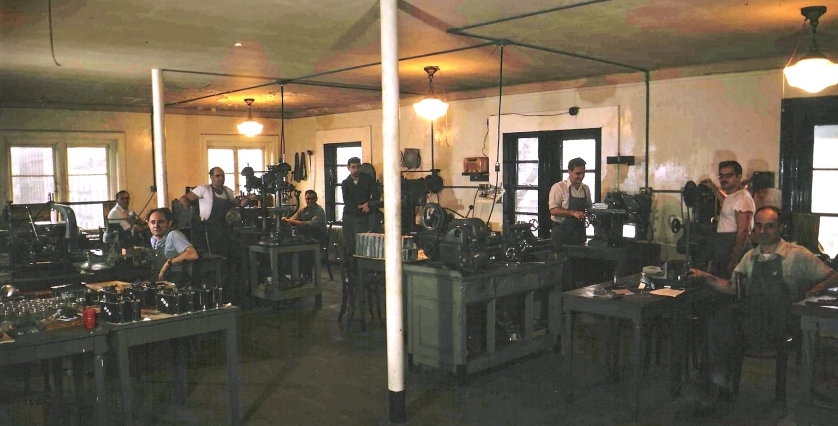

Thanks to Paul Yager and Helen Yager who sent me their reactions
on my publication about their father Victor Yager
the designer and manufacturer of the Vidax Camera.
"I don't remember 100 cameras being made. I was only about 10 years old and believe there were only about a dozen made in the basement of our house in Queens, N.Y.. My son has one along with many parts and drawings. Where did you get the information about 100 cameras. My father had a machine shop in the basement which is where I learned my machine skills. He may have contracted with someone to build more but I remember opening boxes with camera castings in small quantities."
"Doing some more investigation regarding the number of cameras made, I discovered my father had a manufacturing facility in a loft building in NYC (Manhattan) I have attached a picture showing the Vidax camera in various stages of assembly in that facility along with some old family members I recognize. I also recognize some of the machinery there that he had in our basement. I would say this picture was taken by my father around 1948. I had 2- 8 x 10 glossy prints made from a small color negative we found. The lighting was poor.
Hope you enjoy the picture."
Paul Yager
e-mail 21th October 2011
Amazing that my fathers cameras would turn up so far from home. He designed and manufactured the Vidax in the basement of our house. I have often heard him mention that Polaroid put him out of business! Don't know if that really was the reason. The cameras were all made by hand, I remember my uncle (his brother) working with him every day. My father also designed the Meridian 4x5 press camera but sold that patent to put a down payment on our house. He taught photography in his early years. Died in 1977 at age 74. As far as photos go I'm not sure what kind of photos you are interested in? Please advise.
Kindest regards,
Helen Romanek
Hello Jo, I am getting photos you asked for together. By the end of next week I will e-mail you. My dad sold his patent of the Meredian to Peerless photo which was then bought out by Berkey Photo. He taught photography at the New York Institute of Photography. In the basement, he had a milling machine, a lathe and a drill press that I remember, and it was only his brother helping him. (I do have pictures which I will send). I did have a camera which I gave to my nephew, his grandson. He also has a box of parts to the Vidax. My dad had other patents of things he worked on, but financially was never able to promote them successfully. He worked for Besseler company and the Clariex Corp before retiring in 1964 or so. In case I forget, I made a mistake, my dad passed away in 1984 not 1977. Regards, HelenWhat is it and why?
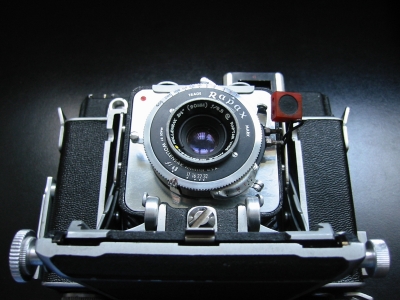
Its quite interesting to answer the last question first. During the last decades before the World War II, press photographers were mainly equiped with 4x5 huge cameras such as the Speed Graphic. These cameras were not only heavy but also very troublesome to use. Before the roll film holder was brought on the market, photographers had to work with plate holders and later sheet film holders with one plate or film on each side of the holder. Before going to an event, photographers loaded a number of plate or sheet film holders in the darkroom, which is almost an act of art and craftsmanship to tinker the plate or sheet film into the holder, making sure that the right side of the film is pointing in the direction of the lens.
Once arrived on the scene, the photographers had to prepare the camera for shooting by estimating and adjusting the subject distance, metering the light and setting the exposure time on the shutter. They had to decide what shutter to use: The front or the focal plane shutter, as most of the Graflex cameras had two shutters: The fast focal plane shutter and the in- between lens shutter on the front standard.
The Focal plane shutter had a number of different slits from wide open for time- exposures up to a narrow slit of some millimetre for the fastest speed shutter time of 1/1000 second. Using the front shutter demands a wide open back-shutter and using the focal plane or back shutter demands an open front-shutter. They had to decide which one of the shutters to use and set the camera appropriately. Beside that they had to insert the holder, pull out the dark slide before shooting and push it back again after exposing.
After the first picture had been taken, they had to pull out the complete film holder, turn the front side of the holder in the back position, replace the holder in the back of the camera, cock the shutter, pull the dark-slide, shoot and so on... It's obvious that photographers who had a lack of experience, often missed a shot or took a blank or a double exposure back at the office . It now becomes clear that the request "one more, Mr. President..., one more!" was very popular with the White House press photographers at the time Harry Truman was President of the United States.
American camera designers were working on new concepts to make the camera lighter and smaller and more reliable and easier to handle. One of these new "compact" camera types was the Kalart camera and the other one was the Vidax. The Vidax camera made its debut in 1948 for a price of US$ 271,00. It is a bellows type folding camera constructed largely of alloy castings and is suitable for sheet and roll film in various sizes. A new concept of build in film mask makes it possible to shoot 8, 12 or 16 frames. Easy film transport, easily interchangeable rangefinder coupled lenses. The focusing track rides on dual racks and pinion.
The name Vidax comes from a contraction of some names from those people who worked on the design of this camera. It is obvious that “Vi” stands for Victor Yager. The same camera maker who designed the famous and legendary Meridian Press Camera.
Beside of the fact that it is an excellent collectors item, it is for all a perfect clever deigned, unique and for all still usable camera. It is a roll film camera which can take 620 Film and for all the still available 120 film. One of the great advantages of the Vidax Camera were the three different film sizes in one camera and on one type of roll film. The lack of a frame mask, which easy can be lost, is one of the big advantages of this camera. The frame masks were of the -build in- type and easy to set. The camera was comparing to its competitors relative small and handhold able but very The other was the fine design and easy to handle and not to forget, it's ruggedly construction of specially hardened aluminum alloy so it could easily survive a fall of 10 feet. More than one model was made before the first Vidax was manufactured. All thinkable bugs were eliminated after several try outs. Comparing to its competitor the Kalart Camera it lacks the double exposure protection.
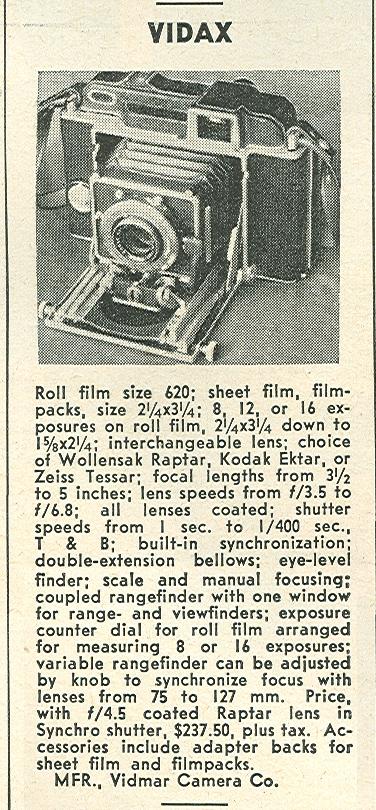

The left side advertisement announced the Vidax with an exposure counter dial and Roll Film Size: 620 film. The right advertisement doesn't mention the counter but announced the 120 film as well as the 620 Roll Film Size. Beside that the two cameras have a completely different top rangefinder housing. As my camera looks exactly like the right one, the left one is probably an earlier design or may be even a proto type.
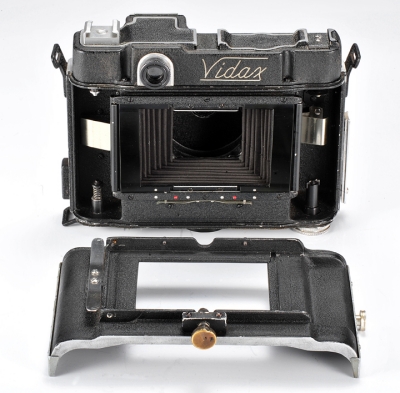
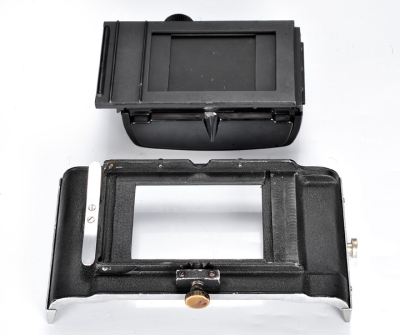
Vidax accessories include adapter backs for sheet film and film pack. Curiously even a Graflex Film Holder finds it place on the adapter.
Courtesy of Mr. Tony Hurst- Dublin
Vidax camera with the suggested standard lens the 101 mm Kodak 4,5 Ektar in flash Supermatic shutter or the Wollensack 4,5 Raptar in Rapax Synchromatic shutter. Both lenses are coated and the shutter speeds range from 1 second to 1/400 of a second. The camera accepts lenses of 65 to 127 mm. A set of 8 slip in mask for the combination view finder range finder window shows the field of view for each different lens. A colour coding system permits instant selection of the right mask and the same colour coding arrangements correlates the infinity stops for the lenses with the scale of the variable rangefinder. The infinity stops are unlike the usual pop up hinged stops like the Graflex and exist simply out of two strips along the sides with a milled groove, in which the lens standard snaps on. Each lens should have its own infinity stops. The infinity strips are 1,6 mm thick. The grooves are 0,5 mm deep. For more lens holder adjusting there is a centre screw right under the lens board. Distance scale adjustment on the left side of the lens standard and a rangefinder adjustment next to the peep hole on the front. By turning this small button, compensation for varying focal lenses is speedily made.
A flexible cable provides the coupling between the focusing bed and the rangefinder. A locking adjustment on the focusing knob, secures the bed at any desired point. Unfortunately I do not have the accessory back for ground glass focusing and use of sheet film. It is obvious that the position of the lens board must be corrected to compensate the shutter position. The movement of the lensboard for correction is accomplished by turning the above mentioned large screw on the front of the lens standard.
Reading all this you'll be convinced that this was not the dream camera of the photographer of the late forties, but it was a huge step in the right direction. On the wish list there would be an automatic shutter-wind and exposure counter, as well as an automatic compensation of the rangefinder for each lens. A body shutter release, a capacitor flash system and a viewfinder masking arrangement. But unfortunately it would never achieved this high standard due to the prematurely end of the manufacturer Vidax Camera Co.
Interesting News
Popular Photography June 1949
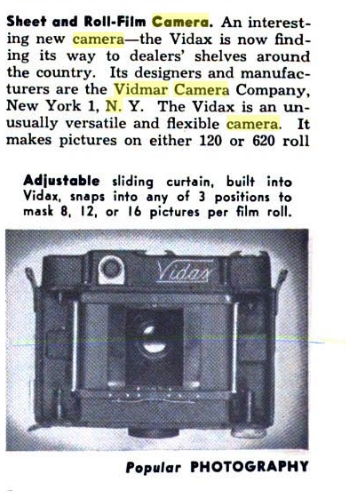

A very interesting article in the Popular Photography June 1949. However, some of the information asks for a deeper investigation.